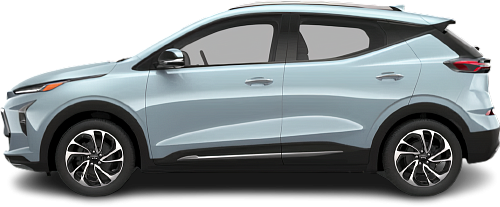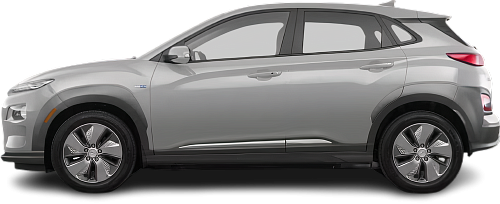Global EV Comparison: Chevrolet Bolt EUV Gen 1 vs Hyundai Kona Electric Long Range
Struggling to Decide? Let AI Help!
Your AI Summary Is Ready!
General Info
Since both vehicles have been discontinued, they are now only available on the used car market. You can get the Hyundai Kona Electric Long Range (2019-2021) for as low as €21990, while the Chevrolet Bolt EUV Gen 1 (2022-2023) was never offered for sale in Europe.
The two vehicles share the same body style: SUV.
| Property | Chevrolet Bolt EUV Gen 1 | Hyundai Kona Electric Long Range |
|---|---|---|
| Years of Production | 2022-2023 | 2019-2021 |
| Current Status | Discontinued | Discontinued |
| Country of Manufacture | USA | Czech Republic, India, South Korea |
| Body Style | SUV | SUV |
| Market Availability | USA | EU, USA |
| Price Europe (Used) | - Price Europe (Used) | €21990 |
| GCC Score | 5.8 | 5.8 |
Range and Efficiency
The Hyundai Kona Electric Long Range (2019-2021) boasts a greater real-world range, a larger battery, and superior energy efficiency compared to the Chevrolet Bolt EUV Gen 1 (2022-2023).
| Property | Chevrolet Bolt EUV Gen 1 | Hyundai Kona Electric Long Range |
|---|---|---|
| Range (EPA) | 398 km | 415 km |
| Range (WLTP) | - Range (WLTP) | 484 km |
| Range (GCC) | 378 km | 403 km |
| Battery Capacity (Nominal) | 65 kWh | 67.5 kWh |
| Battery Capacity (Usable) | 61.8 kWh | 64 kWh |
| Efficiency per 100 km | 16.3 kWh/100 km | 15.9 kWh/100 km |
| Efficiency per kWh | 6.12 km/kWh | 6.3 km/kWh |
| Range and Efficiency Score | 7 | 7.5 |
Charging
Both vehicles utilize a standard 400-volt architecture.
The Hyundai Kona Electric Long Range (2019-2021) offers faster charging speeds at DC stations, reaching up to 77 kW, while the Chevrolet Bolt EUV Gen 1 (2022-2023) maxes out at 55 kW.
The Chevrolet Bolt EUV Gen 1 (2022-2023) features a more powerful on-board charger, supporting a maximum AC charging power of 11.5 kW, whereas the Hyundai Kona Electric Long Range (2019-2021) is limited to 11 kW.
| Property | Chevrolet Bolt EUV Gen 1 | Hyundai Kona Electric Long Range |
|---|---|---|
| Max Charging Power (AC) | 11.5 kW | 11 kW |
| Max Charging Power (DC) | 55 kW | 77 kW |
| Architecture | 400 V | 400 V |
| Charge Port | CCS Type 1 | CCS Type 2 |
| Charging Score | 6 | 5 |
Performance
Both vehicles are front-wheel drive.
Both cars offer the same motor power, but the Chevrolet Bolt EUV Gen 1 (2022-2023) achieves a faster 0-100 km/h time.
| Property | Chevrolet Bolt EUV Gen 1 | Hyundai Kona Electric Long Range |
|---|---|---|
| Drive Type | FWD | FWD |
| Motor Type | PMSM | PMSM |
| Motor Power (kW) | 150 kW | 150 kW |
| Motor Power (hp) | 201 hp | 201 hp |
| Motor Torque | 360 Nm | 395 Nm |
| 0-100 km/h | 7.3 s | 7.9 s |
| Top Speed | 146 km/h | 167 km/h |
| Performance Score | 3.5 | 3.8 |
Dimensions
The Chevrolet Bolt EUV Gen 1 (2022-2023) is longer and taller, but about the same width as the Hyundai Kona Electric Long Range (2019-2021).
The Chevrolet Bolt EUV Gen 1 (2022-2023) boasts a more extended wheelbase.
| Property | Chevrolet Bolt EUV Gen 1 | Hyundai Kona Electric Long Range |
|---|---|---|
| Length | 4306 mm | 4180 mm |
| Width (with Mirrors) | - Width (with Mirrors) | 2070 mm |
| Width (w/o Mirrors) | 1770 mm | 1800 mm |
| Height | 1616 mm | 1570 mm |
| Wheelbase | 2675 mm | 2600 mm |
Cargo and Towing
The Chevrolet Bolt EUV Gen 1 (2022-2023) provides more cargo capacity, featuring both a larger trunk and more space with the rear seats folded.
Neither car is equipped with a frunk (front trunk).
Neither vehicle is officially rated for towing in in the EU.
| Property | Chevrolet Bolt EUV Gen 1 | Hyundai Kona Electric Long Range |
|---|---|---|
| Number of Seats | 5 | 5 |
| Curb Weight | 1669 kg | 1760 kg |
| Cargo Volume (Trunk) | 462 l | 332 l |
| Cargo Volume (Max) | 1611 l | 1114 l |
| Cargo Volume (Frunk) | - Cargo Volume (Frunk) | - Cargo Volume (Frunk) |
| Towing Capacity | - Towing Capacity | - Towing Capacity |
| Cargo and Towing Score | 6 | 5.3 |




